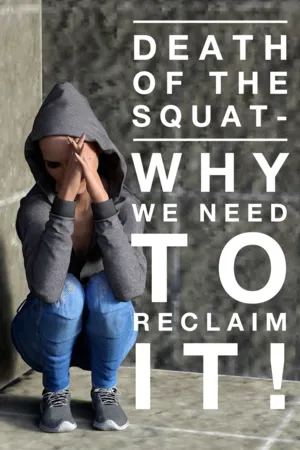Before my days of enlightenment of an epidemic in our modern day society, I too viewed a squat as an athletic activity. Something that only athletes or people at a gym would do. Certainly not the everyday person like my friends, parents, and people I knew around my community… unless they were working out. And a full, deep to the floor kind? Umm, no. That deep squat that we see done on National Geographic films in far away lands is definitely dead in the western world.
So whats wrong with NOT squatting?
As a physical therapist for the past decade, I have treated all kinds of orthopedic issues in the general public as well as athletes. I would prescribe the medicine of my choice. Movement. As an old dancer, then dance instructor, then exercise physiology major, and then physical therapist, I felt pretty confident in analyzing people’s quality of movement and how they exercised. When I knew that a person needed to increase their hip and knee strength, a mini or moderate squat was usually prescribed at some point along with other key muscle exercises. I confidently guided them towards the correct positioning of their hip, knee, and ankle joints.
Then one day, I had a high school athlete in my office with low back pain. His complaint was primarily while doing heavy squats of over 250 pounds. By all measures, this was a healthy and physically fit young man. As I broke down his squat mechanics, I kept going further towards the most basic components of the movement because his squat didn’t look too bad. We went down to the isometric glute contraction (contracting the muscle without moving the body). Here was the big surprise. While sitting, we realized he was unable to contract the gluteal muscles on their own. Instead, his thigh and back muscles took over aggressively despite him trying not to let them. They were trying to compensate for the glutes entirely. He seriously could not isolate a basic gluteal squeeze! Then we tried in different positions. Laying on his back, stomach, standing. All with the same result. So as crazy as it sounds, his movement medicine was to go home and perform basic gluteal contraction’s (ahem, butt muscle contractions) while sitting standing and laying down. Focusing on true muscle isolation without thigh or back muscle over-recruitment. This young man was highly motivated because he could not understand why he (an athlete) could not do something so simple. After only a few weeks, he was able to isolate his glute muscles independent of his thigh and back muscles. We were able to retrain his squat (with glutes on board this time) and his back pain was gone.
So if you stop here, you are going to think, “if an athlete has pain with a squat, then it REALLY isn’t for me!”
Well, not so fast. The bigger question, is WHY didn’t this healthy young man have voluntary control of the BIGGEST muscle group in the body?! And an athlete at that! I will tell you why. He, like everyone else in the developed world has been using chairs since he was at least a kindergartner. The older he got, the less and less time he spent playing on the ground, and more time spent sitting in a school chair, a couch, a car seat, a bike seat. Our muscles are designed brilliantly. They are efficient. They are not going to stay super strong if we don’t use them. And they are also not going to stay strong in all body positions if we never go into them. Like with a squat. So basically, the mantra of USE IT OR LOSE IT.
The typical squat to the ground is still seen today with toddlers, babies, and people in other areas of the world where they still rest from standing by squatting or where their toilets are in the ground. Hello, Squatty Potty anyone??
The result for us “civilized westerners”, is that our bodies are suffering big time. The entire area of the hips and pelvis are basically malnourished from a movement standpoint. These muscles are never being used in their most lengthened positions and WILL become dysfunctional. It is no secret to physical therapists and biomechanical experts that the real source of chronic knee and most hip pains are related to lack of hip muscle strength. From there, the joints will track irregularly and slowly break down over time. And how about other muscles in the area? The pelvic floor muscles are also suffering. This can lead to urinary and bowel incontinence, pelvic floor pain, and for men and women, issues with sexual function. Also, consider the pelvic floor the core of the core. If these muscles are not functioning properly, there is a snowball effect in terms of the ability to stabilize the spine.
“The result for us “civilized westerners”, is that our bodies are suffering big time. The entire area of the hips and pelvis are basically malnourished from a movement standpoint.”
I have been discovering this issue with numerous individuals for several years now. All ages and ability levels. People are shocked when we test out their hip muscle control and coordination and find that they either cannot isometrically isolate these muscles or keep them contracted while doing something as simple as moving from sitting in a chair to standing. Even if their squat positioning looks ideal. With motivation and the correct guidance, muscle coordination and strength that was lost, can be regained. What is scary to me now, is knowing that a likely majority of people participating in their exercise programs and classes where squats are involved, have the same issue due to a lifetime of chair usage. When doing squats, they are likely dominating with their thigh and back muscles and their gluteals are just checked out.
What can symptom-free people do?
Regain your squat. Try to get into the position the best you can. If you cannot, what is limiting you? Are your calves too tight? Try stretching them. Until they are flexible enough, place your heels on a small ledge of 2-3 inches to compensate. Do other activities in a squat position such as check emails on your phone or just take a break from sitting. Use a squatty potty.You can also work with a movement expert such as myself, a physical therapist. I will caution, that this issue is not usually on most PT’s radar. The better you can squat and the longer in your life you can do so will help you prevent a boat load of physical ailments. Just think of the phrase from an elder alert system from years back “I’ve fallen and I can’t get up!”.
What if I already have knee or hip pains?
The best plan is to work with a professional. The goal is to get as much muscle coordination and strength as possible in the available range of movement. Avoid sitting on the tallest surface because it is easier to get off of. Your quality of life is depending on it.
Why is a pelvic floor expert talking about squats?
Most of the clients I have seen over the years for pelvic floor issues have also had imbalances in the entire hip/pelvis area. Only with addressing the whole body, can true healing take place with the pelvic floor muscles. The long held belief that “doing your Kegels” will keep your pelvic floor fully functional is just not correct. Besides, most people I see have never actually been properly instructed in a Kegel and couldn’t do one even if their doctor gave them this advice.
Issues with urinary stress incontinence (leaking with activity) and other pelvic floor conditions such as pelvic pain from a too short or tight pelvic floor are affecting as many as 30% of women and is on the rise. When you combine that information with the fact that our society is becoming more and more sedentary, it just makes sense to address the whole moving person instead of singling out the pelvic floor muscles. Especially given the fact that they are not activated properly or positioned in the ideal length-tension in the absence of normal glute contractions with our everyday movements. While squat training alone will not normalize all pelvic floors, it is a significant component that cannot be overlooked.
There are professionals out there that are realizing the significance of the squat as it relates to pelvic floor muscle function, but they are few. I am doing my part to spread the awareness.



